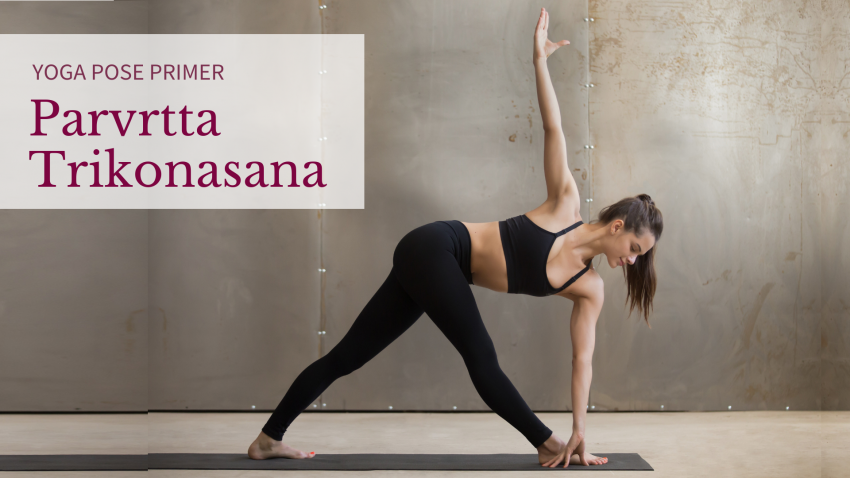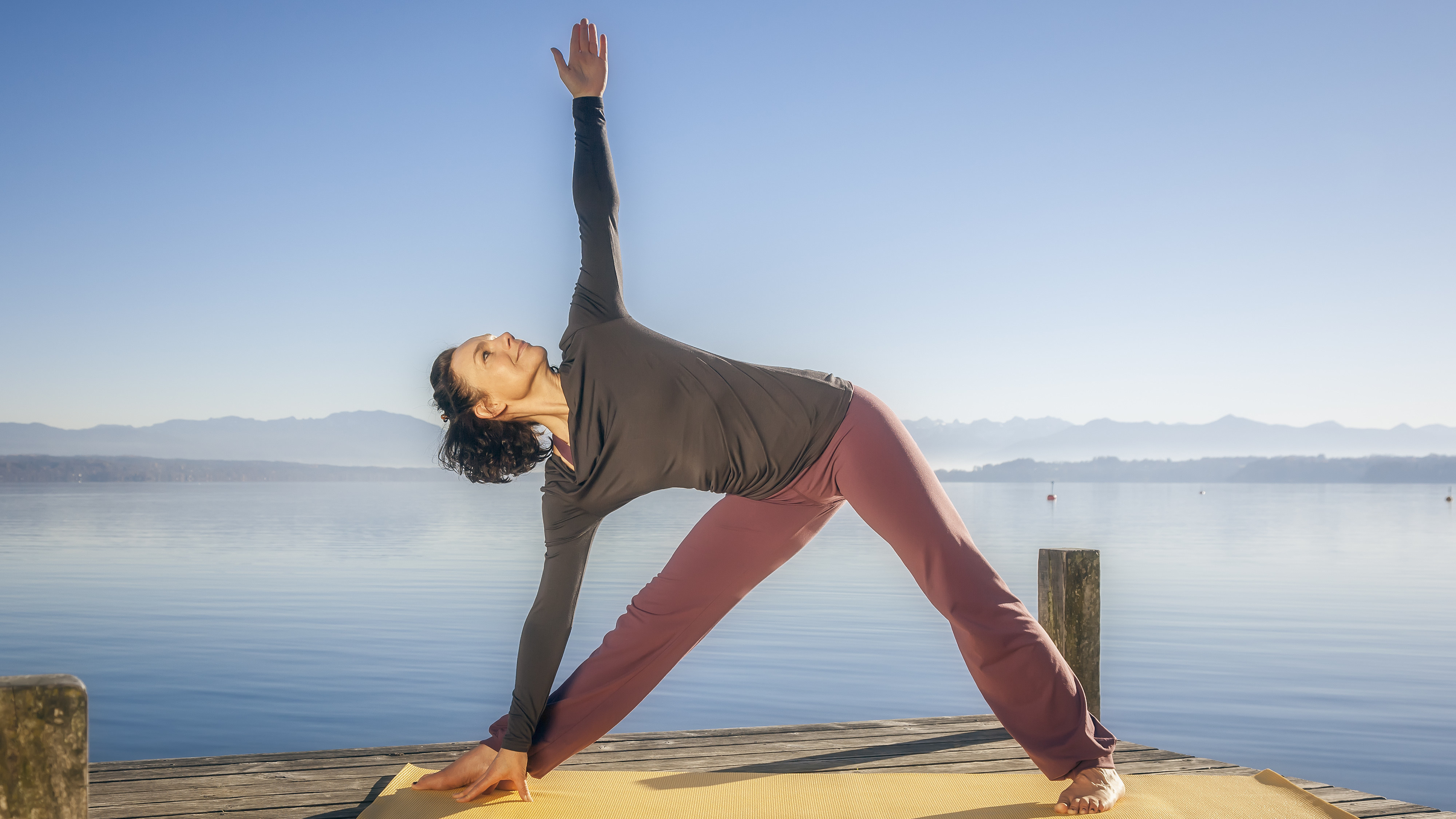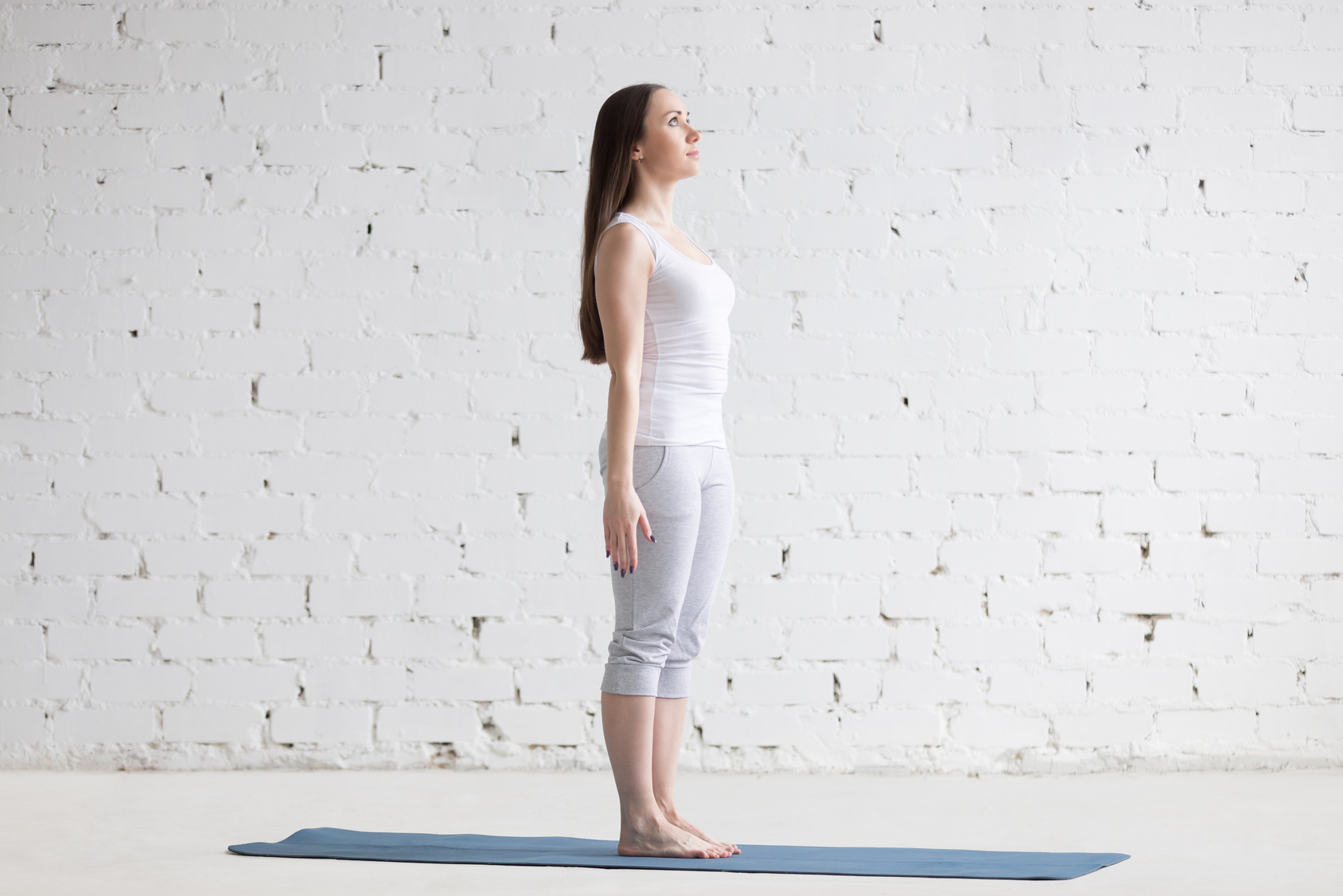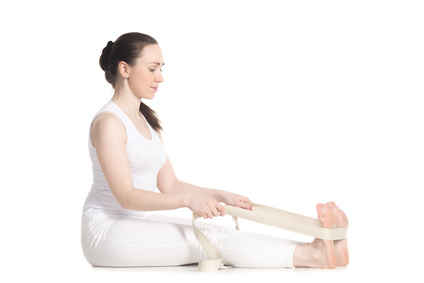View basket (0 items $0.00)

Yoga Pose Primer: Parvrtta Trikonasana (Revolved Triangle Pose)
If I had to pick the most complicated asana in the canon of common poses, Parvrtta Trikonasana (Revolved Triangle Pose) would be among the top few. Parvrtta Trikonasana is a balance pose, a spinal rotation, a forward bend, and even contains an element of backbending.
One of the trickiest things about Revolved Triangle Pose is that we often prioritize placing our bottom hand on the floor, sacrificing the length of the torso and freedom of the breath. It’s helpful to remember that maintaining deep, full breathing is always more important than forcing your body into the “full expression”—i.e., the most extreme version—of any pose.
The easiest way to ensure that your breathing stays free and relaxed is to make sure that your bottom hand is always high enough up that you can keep both sides of your torso equally long. The poses I describe below, using a wall and a yoga block, can teach you how to maintain spinal integrity in the pose.
While it’s definitely a challenging pose, Parvrtta Trikonasana can be beneficial when you warm up sufficiently and practice with the intention to cultivate deep, relaxing respiration.
Revolved Triangle Pose Benefits:
-
Helps you develop steady balance
-
Tones and strengthens the legs
-
Mobilizes the thoracic spine
-
Stimulates abdominal organs
Revolved Triangle Pose Contraindications:
-
Injured or compromised neck
-
Hamstring injury
-
Sacroiliac issues (Any spinal rotation can be hard on the SI joint.)
-
Pregnancy (Twists of any kind are contraindicated in the first trimester. After the first trimester, once the abdomen begins to expand, this pose can become really difficult.)
Preparing for Parvrtta Trikonasana (Revolved Triangle Pose)
Many elements must come together in Revolved Triangle. So it’s important to warm up carefully. When I teach or practice this pose, I make sure to prepare by practicing the following types of poses beforehand:
-
Standing poses, such as Trikonasana (Triangle Pose) (photo below), Parsvottanasana (Pyramid Pose) and Parsvakonasana (Side Angle Pose)

-
Hamstring stretches, such as Uttanasana (Standing Forward Bend) and Prasarita Padottanasana (Wide-Legged Standing Forward Bend)
-
Spinal rotations, such as Parvrtta Sukhasana (Revolved Easy Pose)
Before you attempt Revolved Triangle, practice the above standing poses, hamstring stretches and spinal rotations. Then, try this:
Upright Parvrtta Trikonasana (Without a Forward Bend)
I love this variation for preparing for Revolved Triangle. Because you don’t bend forward in this variation, you can focus on spinal rotation. It’s far easier to create the spinal twist when your torso is still upright before moving into the forward bend than it is to try to rotate your torso when you’re already bending forward.
-
Place a non-skid yoga mat parallel to a wall so that the entire edge is against the wall.
-
Stand with your feet hip-width apart at the front end of your mat with the right side of your body 6 to 8 inches away from and facing the wall.
-
Step your left foot straight back 2 to 3 feet, keeping your feet hips-width apart from left to right, and pointing your left foot mostly forward. It will need to angle outward slightly.
-
Plant your left foot. Then begin internally rotating the left leg (toward the wall). Begin at the ankle, and then rotate the shin, knee, thighbone, pelvis, and finally, the ribcage. Place your hands on the wall at chest level to facilitate the twist.
-
Keep your head in a neutral position, so that you’re looking at the wall.
-
Stay upright and breathe into the twist, lengthening your spine as you ground your feet.
-
Stay for 5 to 10 deep breaths.
-
Rotate your torso back to the center.

-
Step your left foot forward and stand in Tadasana (photo right), checking in with what you feel. How do the two sides of the body differ?
-
Now walk to the other end of your mat and stand in Tadasana with your left side facing the wall and repeat the pose.
Revolved Triangle Pose (Parvrtta Trikonasana)—At the Wall with a Block
After practicing the above pose, stay at the wall and practice Upright Revolved Triangle Pose again, but this time add a forward bend.
-
Repeat steps 1 through 7, but this time, place a yoga block so that it’s standing on its end, at its highest height, between your feet before you start. If you find later on that you can lower the block to one of its shorter levels without compromising the length of your torso and your ability to breathe easily, feel free to do this.
-
After you’ve done steps 1 through 7, ground your feet and extend left arm out in front of you, extending the entire torso, head to tail, along with it.
-
Keep extending outward as you lower your left hand and place it on your block.
-
Place your right hand at the wall to stabilize your balance and to facilitate the spinal rotation. Extend your pelvic floor back, away from the head.
-
Draw the hip of your right leg back.
-
Take 5 to 10 deep breaths here.
-
Lift your torso up, unwind the rotation of your ribcage, and step your left leg forward.
-
Stand in Tadasana for a moment to check in with how you feel after the pose.
-
Repeat on the other side.
Practicing these two poses before trying Parvrtta Trikonasana in the middle of the room helps prepare your body and teach you a step-by-step method for moving into the pose, without having to worry about your balance.
If you want to try practicing in the center of the room, follow the same steps as above, except, of course, without placing your hands on a wall. If your breathing feels relaxed and your torso is long, you can try placing your block on the outside rather than the inside of your foot. 
After practicing Revolved Triangle, be sure to follow with some symmetrical poses such as Adho Mukha Svanasana (Downward Facing Dog Pose), Upavista Konasana (Wide-Legged Seated Forward Bend) and/or Paschimottanasana (Seated Forward Bend) (photo right). Breathe generously into your back body in these poses, and then follow with a nice, long Savasana.
Another Yoga Pose Primer from Charlotte Bell - Yoga Pose Primer: 7 Steps for Practicing Baddha Konasana.
 Charlotte Bell began practicing yoga in 1982 and began teaching in 1986. She was certified by B.K.S. Iyengar in 1989 following a trip to Pune. In 1986, she began practicing Insight Meditation with her mentors Pujari and Abhilasha Keays. Her asana classes blend mindfulness with physical movement. Charlotte writes a column for Catalyst Magazine and serves as editor for Yoga U Online. She is the author of two books: Mindful Yoga, Mindful Life and Yoga for Meditators, both published by Rodmell Press. She also edits Hugger Mugger Yoga Products¹ blog and is a founding board member for GreenTREE Yoga, a non-profit that brings yoga to underserved populations. A lifelong musician, she plays oboe and English horn in the Salt Lake Symphony and the folk sextet Red Rock Rondo whose 2010 PBS music special won two Emmys.
Charlotte Bell began practicing yoga in 1982 and began teaching in 1986. She was certified by B.K.S. Iyengar in 1989 following a trip to Pune. In 1986, she began practicing Insight Meditation with her mentors Pujari and Abhilasha Keays. Her asana classes blend mindfulness with physical movement. Charlotte writes a column for Catalyst Magazine and serves as editor for Yoga U Online. She is the author of two books: Mindful Yoga, Mindful Life and Yoga for Meditators, both published by Rodmell Press. She also edits Hugger Mugger Yoga Products¹ blog and is a founding board member for GreenTREE Yoga, a non-profit that brings yoga to underserved populations. A lifelong musician, she plays oboe and English horn in the Salt Lake Symphony and the folk sextet Red Rock Rondo whose 2010 PBS music special won two Emmys.
Featured Courses








